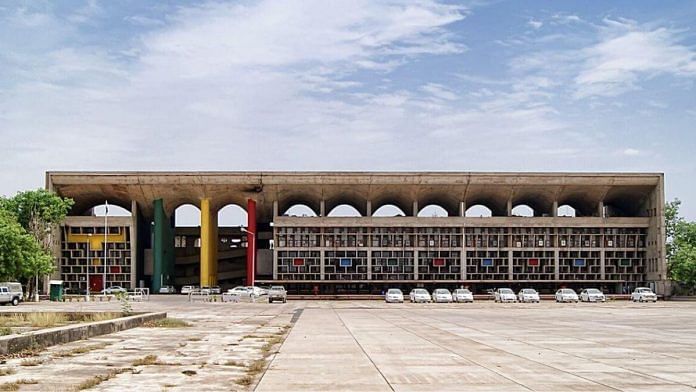New Delhi: In a significant ruling Wednesday, the Supreme Court upheld the Punjab and Haryana High Court’s directive to construct a verandah outside Courtroom No. 1—part of the Chandigarh Capitol Complex, a UNESCO World Heritage site—and install green paver blocks in the open parking area just outside the court complex.
The decision, delivered by a bench of Justices Vikram Nath and Sandeep Mehta, rejected the Chandigarh Administration’s appeals, which had flagged potential risks to the complex’s UNESCO heritage status.
The administration also contended that the open parking area, designated as a green belt under the Chandigarh Masterplan 2031, should be reserved exclusively for tree planting.
The apex court’s verdict resolved a contentious legal dispute sparked by a public interest litigation (PIL) filed by Vinod Dhattarwal and others, emphasising the infrastructural needs of the Punjab and Haryana High Court while addressing the administration’s heritage and environmental concerns.
The PIL sought remedies for issues like parking shortages and inadequate protection for litigants and lawyers from the elements outside Courtroom No. 1, where the Chief Justice presides.
Chandigarh administration’s objections
Designed by the legendary French-Swiss architect Le Corbusier in the 1950s, the Chandigarh Capitol Complex, encompassing the High Court, Secretariat, and Legislative Assembly, was designated a UNESCO World Heritage Site in 2016.
The High Court’s heritage status imposes stringent guidelines to preserve its architectural and cultural integrity, making any structural modification a matter of global scrutiny.
The controversy began when the Punjab and Haryana High Court, in a series of orders—dated 29 November, 2024; 13 December, 2024; 7 February, 2025; and 21 February, 2025—directed the Chandigarh Administration to construct a verandah outside Courtroom No. 1, mirroring those already existing outside Courtroom Nos. 2 to 9.
The High Court also mandated the use of eco-friendly green paver blocks in the kutcha parking area to address the acute shortage of parking spaces, while ensuring plantation of 100-200 trees to maintain the area’s green belt status under the Chandigarh Master Plan, 2031.
The Chandigarh administration challenged these orders, arguing that the verandah construction risked compromising the High Court’s Outstanding Universal Value (OUV) and could lead to the loss of its UNESCO World Heritage status. It also contended that the kutcha parking area, designated as a green belt, should not be altered with paver blocks, as it would irreversibly change its character.
Supreme Court’s ruling
The Supreme Court, in its 28 May, 2025, judgment, rejected the Chandigarh Administration’s objections, finding the High Court’s orders well-reasoned and aligned with sustainable development principles.
On the verandah issue, the bench noted that the proposed structure would align with the existing verandahs outside Courtrooms Nos. 2 to 9 and would not constitute a “major restoration or new construction” under UNESCO’s Operational Guidelines, as mentioned in paragraph 172 of the Guidelines.
The court emphasised that modern architectural techniques could ensure a removable or collapsible verandah, preserving the building’s aesthetic and heritage value.
The bench also referenced a 1956 letter from the Chandigarh Administration, which revealed that a similar verandah proposal was considered but rejected by the then-Chief Justice due to personal concerns about potential disturbances.
The court dismissed the relevance of this decision, noting that the dynamics of court functioning have changed significantly over the past seven decades, with rainwater seepage into Courtroom No. 1 causing damage and inconvenience.
Regarding the green paver blocks, SC endorsed the High Court’s directive to lay eco-friendly pavers in the kutcha parking area, which is already used by 3,000–4,000 vehicles daily.
The court highlighted that green pavers allow rainwater percolation, reducing dust and sludge while maintaining ecological balance.
It further directed the High Court administration to consult landscaping experts to plant trees at regular intervals alongside the pavers, enhancing both parking facilities and green cover.
The court also addressed the Chandigarh administration’s concerns about the green belt designation, citing its own precedent in Rajeev Suri v. Delhi Development Authority (2021), which upheld sustainable development as a balance between environmental preservation and public interest.
The bench found that the High Court’s orders struck this balance effectively.
While upholding the High Court’s directives, the Supreme Court granted the Chandigarh Administration a 12-week period to comply with the verandah construction order, keeping contempt proceedings against Chief Engineer C.B. Ojha in abeyance.
This followed the High Court’s 13 December, 2024, order issuing contempt notices for non-compliance with the earlier directive.
During the hearings, Solicitor General Tushar Mehta, representing the Chandigarh administration, argued that the verandah construction required prior approval from the UNESCO World Heritage Committee and Fondation Le Corbusier, Paris, to avoid jeopardising the Capitol Complex’s heritage status. He also opposed the green paver blocks, citing the Chandigarh Master Plan’s green belt designation.
Senior counsel Nidhesh Gupta, representing the High Court administration, countered that the verandah was a minor, reversible addition, consistent with existing structures and necessary to protect litigants and the courtroom from weather damage.
He emphasised that green paver blocks were an eco-friendly solution to the parking crisis, with no adverse impact on the green belt’s ecological function.
(Edited by Zinnia Ray Chaudhuri)
Also read: How a procedural lapse led to acquittal of Haryana doctor-couple in a 19-yr-old PNDT Act case







Of course. Why not?
Our milords have appropriated all powers and severely encroached into the domains of the executive and the legislature. Whatever these milords say, we all must accept it as the gospel truth.
Some milord somewhere wanted a balcony in his office and he got it built. To hell with UNESCO rules and regulations. These rules are meant for ordinary citizens like us. Milords can get away with anything and everything.